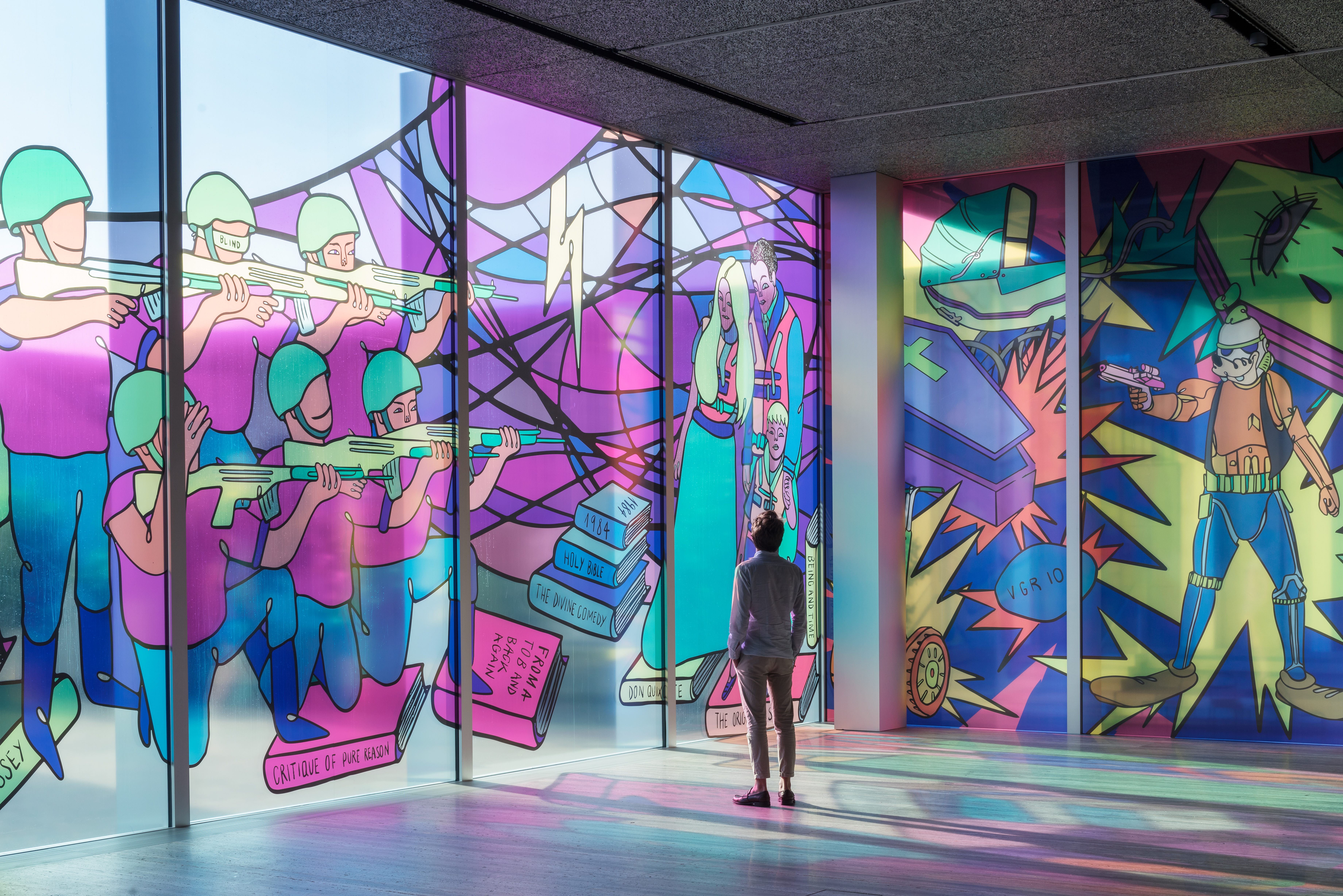
A few days ago in Milan, Italy, the Nobel Prize-winning Turkish author Orhan Pamuk, who is also the founder of Istanbul’s Museum of Innocence, was a keynote speaker at the yearly conference of International Council of Museums (ICOM). In a video-link message he delivered the following pearl: “In the future,” he said, “we need small and economical museums that address our humanity.” At the year-old Fondazione Prada this summer, it’s a case of shared humanity—but in a highly uneconomical envelope.
Not exactly a small museum, the 23-year-old Fondazione Prada’s 120,000-square-foot permanent venue in Milan (the foundation also has a palazzo on Venice’s Grand Canal) is sited at a former distillery in the decidedly industrial south side of the world’s most fashionable city. Predictably, it was designed by starchitect Rem Koolhaas, who has also built stores for the fashion giant in New York and Los Angeles.
Koolhaas’s sober design is the opposite of the kind of flashy architecture recently revealed at other private museums around the world—consider Frank Gehry’s ditched sailboat at the Fondation Louis Vuitton in Paris, and Diller, Scofidio + Renfro’s rhomboid with a veil at the Broad Foundation in Los Angeles. Additionally, the Fondazione’s sole patrons— Miuccia Prada and her partner Patrizio Bertelli—are not venture philanthropists in the mold of Eli Broad and Bernard Arnault. Not only does the couple give the appearance of being kinder, gentler billionaires, they have consistently declared their commitment to making their foundation “an expression of [artistic] freedom.”
As Prada and Bertelli told the Financial Times last year, the pair is not looking to collaborate with artists to upscale their primary business (like Louis Vuitton’s rebranding campaigns with artists Takashi Murakami and Yayoi Kusama); also, they are definitely not searching for the art world’s approval. “The idea of the foundation,” they have stated, “is that it represents something significant, a proper act of research.” The institution, Bertelli has added, actively shuns go-along agreement: “It is against consensus. Looking for consensus is a form of mediocrity, and that is one of the worst of human weaknesses.”
Theaster Gates at Fondazione Prada. Courtesy of Getty Images.
Which brings us to how the Fondazione Prada comes to showcase a pair of exhibitions by two divergent yet complimentary, charismatic black artists: the American sculptor, performer and urban planner Theaster Gates, and the Angolan multimedia maven Nástio Mosquito. Brought together by Elvira Dyangani Ose—a gimlet-eyed curator based in London—their joint shows sharpen the soft edge of the Fondazione’s popped collar aesthetic. If at times these artists’ pushy works risk landing amid this world capital of design like brothers from another planet, their work also genuinely bristles—coming across as intense, irritable, urgent even.
Take Mosquito’s stained-glass installation, which is sited inside the Fondazione’s impressive ground floor “Podium” gallery. A large central nave around which the museum’s other industrial buildings revolve, the Podium features floor to ceiling glass walls which Mosquito has duly covered with colorful comic-book drawings that echo the monumental apse windows of Milan’s famous Duomo.
Instead of biblical stories like the Tower of Babel, however, Mosquito’s narrative tends to world embracing mythological chaos. In one window treatment, rifle-toting soldiers take aim at a Holy Family, which is all white, while trampling a copy of Immanuel Kant’s Critique of Pure Reason; in another, a bare-breasted Medusa appears to toss an “Obama Yes” coffee mug into the air.
Nastio Mosquito at Fondazione Prada. Courtesy of Getty Images.
Mosquito amps up the secular church feel of his installation—which is appropriately titled WEorNOT (Nastivicious’ Temple #1)—by introducing half a dozen irregularly placed black pews around the open space. On each are inscribed a series of mottoes that suggest previous lives as African proverbs (Mosquito was born in Luanda, Angola, but lives in Ghent, Belgium). “In the land of the blind, a one single eyed being,” affirms one. A second reads: “When elephants battle is (sic) the grass that suffers.” Every so often electronic music is piped into the gallery, mostly to keep audiences from getting too comfortable.
But if Mosquito’s religious and politically incorrect gallery-as-a-place-of-worship aspires to critical transcendence, it’s Gates’s installation that beats the drum for a transformative aesthetics of black artivism most insistently.
Theaster Gates, True Value (2016). Courtesy of Fondazione Prada.
Titled “True Value,” the Chicago-based artist’s exhibition consists of two parts. The first is comprised of a number of newly created or found objects Gates imbues with sacramental-artistic meaning. They include a tar mop and bucket sculpture, several Janus-faced glazed stoneware masks (Gates describes these as self-portraits reflecting the tension between “his everyday person and his successful artistic persona”), and a genuine Boli. This last is a sacrificial power figure made by the Bamana people of Mali. Constructed from encrusted dirt, foodstuffs, animal blood and other materials, the animal-shaped sculpture does what all ambitious art should aspire to—it packs a whole cosmogony into object form.
The centerpiece of “True Value,” though, is Gates’s exportation and reinstallation of an entire inner city hardware store inside the pristine Fondazione Prada. Like many ex-mom and pop enterprises throughout America, this South Side hardware store—once sited at the corner of 93rd and Halsted Streets in Chicago—was lost to the twin forces of urban decay and big box stores. As art, it closely resembles The Caddy Court (1986-87), an Edward and Nancy Kienholz car sculpture the Fondazione currently has on the premises. As a spirited reclamation of reality, it functions like a messy but loving memorial. Its rows of light bulbs, pipes, washers, rope bundles, broom handles, sports trophies, and peg board rise inside Rem Koolhaas’s bare sunlit galleries—with their echoes of stupendous wealth and winner-take-all inequality—like a monument for the postwar, post-industrial city.
Few things look as forlorn, or beautiful.